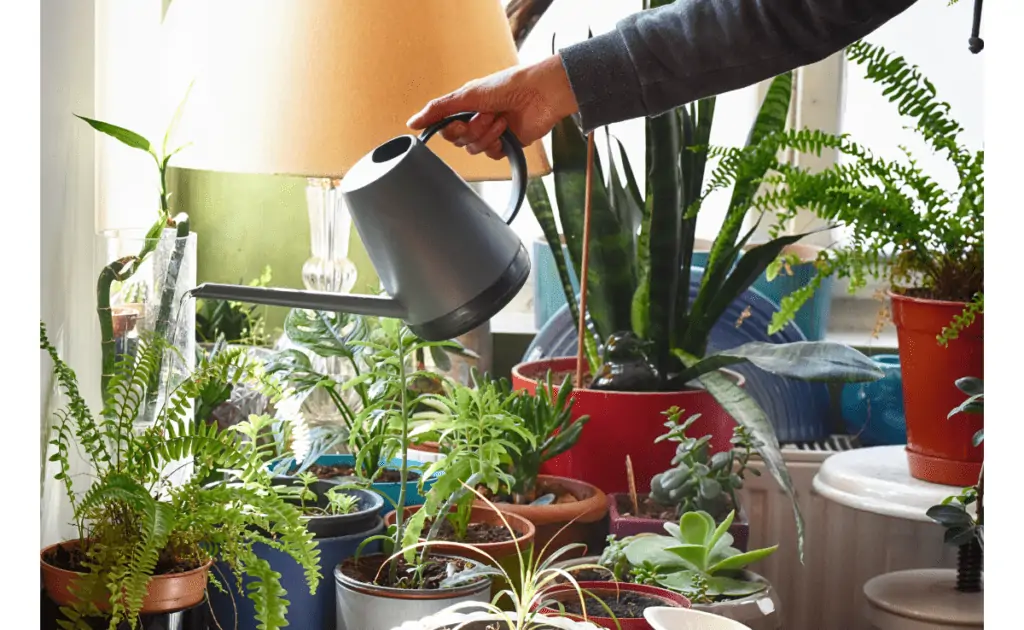
It’s easy to make an indoor garden for your apartment when there are limited resources. Almost anything can be used as a planter to grow plants indoors. You can even use materials that you already have in your home. What matters is that it’s fun and functional to help grow plants inside using minimal space without requiring too much outside care.
What can be grown in an apartment or rooftop gardens ?
As far as what can be grown in a apartment garden with artificial light, several different vegetables are good options. Tomatoes tend to grow very well since they require only strong lighting (grow lamps) and little water over their short growing cycle (fifty-two days). Check out our Growing Tomatoes article for more tips on keeping your tomatoes healthy. Peppers are also a great alternative. These plants are not as sensitive to their lighting requirements and can produce fruit through the winter months.
Cucumbers grow quickly, and since they are largely made up of water, they are another source of hydration to people living in apartment buildings. Amongst all vegetables, cucumbers tend to be the easiest to grow in apartments or on rooftop gardens. If anyone has ever grown a cucumber plant from a seedling, it is probably because they have tried many times unsuccessfully before. Yet once a successful small plant is grown in apartments, these plants can produce several pickles throughout the year. If you notice your plant beginning to struggle, check out our Fixing Common Cucumber Plant Problems for advice on how to revive it.
Likewise, beans need less light than other vegetables while tolerant of poor soils. Since they do not require much time on a full-size trellis, beans only take about ten weeks to produce.
There are many more options for vegetables that can be grown indoors throughout the year. However, strawberries are one of the most popular since they taste better than ones bought at grocery stores. Strawberries are perennials, meaning they continue to grow over multiple years. They do not require much space, just a container with some soil and sunlight through a windowpane. With about six plants in a six-gallon pot, strawberries will provide almost five pounds of fruit each year! Don’t forget herb garden is a great choice for any apartment container garden. Learn how to preserve your herbs in this post.
A home producing several vegetables is certainly an improvement over people being forced into supermarkets every week to buy food. It cuts down on costs for eating healthy while also providing opportunities to learn skills like gardening. If you have limited outdoor space or live in an apartment, there are many ways to grow food throughout the year. Check out our article How to Create a Garden in a Small Space for more ideas on how to use limited space.
How plants are grown indoors without sunlight (garden ideas)
The lack of sunlight is a major issue faced by some people who want to grow plants indoors. While it might be possible for you to purchase artificial lighting equipment, such as CFLs and special bulbs, this guide will introduce several easy and cheap ways to get your desired results without any additional lighting equipment.
1) Grow lights
This is the most basic form of indoor growing using no natural light. These are rather inexpensive and can easily be purchased from local hardware stores or online shops. Be sure that you get one that has an automatic power-off function (so you don’t forget to turn off the lights). When buying these, make sure they use less than 150W; otherwise, they may burn out more quickly. We cover grow lights in depth in our Best Light for Indoor Garden post.
2) Water plants at the appropriate time
Normally plants don’t grow well without sunlight, but because living things are adaptive, they can do so if you give them enough water. However, not all plants should be watered just after sunset – some need first to absorb liquid via their roots before they can be watered again – so these instructions must be considered when planning how much to water your plants. Additionally, some plants should never be overwatered (i.e., only given water periodically).
3) Choose the right plant for the job
Not every type of plant is compatible with indoor growth; choose those suited for low-light conditions and low water availability (for example, cacti or succulents). Generic houseplants will not do well if grown indoors without sunlight. For the best indoor plants for low light, check out this post.
How often should indoor vegetables and herb garden be watered?
Vegetables are very sensitive to the amount of water they are given, so too much or too little can be harmful. Many factors affect how often vegetables should be watered, including the age of the plant, its location in your home, and even what type of vegetable it is.
Otherwise, healthy vegetables which have just been transplanted into a bigger pot require more frequent watering than established plants. Once you’ve established how frequently your vegetables need watering, stick to that schedule every time for best results!
Young seedlings grown indoors need frequent light wettings of their soil surface with tepid water between 6-10 times per day. Larger seedlings outdoors may only need this treatment on sunny days when temperatures are warm.
The main aim is to keep the surface of the compost moist but not wet and soggy, which can cause fungal problems, meaning it’s a good idea to water at the soil level rather than from above. If you’re using a container with drainage holes, make sure these are kept clear of debris as blockages will lead to waterlogging. An emergency bucket or watering can be used for seedlings that have outgrown nearby plant pots – carefully pour some water into the bottom few centimeters (inches) of their pot until it begins seeping through the drainage hole(s).
Although many plants grow well in normal room temperatures, over half of hanging baskets and house plants need warmer conditions to remain healthy and active, especially at night. This applies especially during winter when days are short and nights long and cool.
Certain plants such as datura (angel’s trumpet) and cacti thrive if their pot is placed in a sheltered sunny or semi-shaded position outdoors towards the end of Summer, where they should remain until autumn frosts begin. By bringing them indoors before this, you can keep these plants growing happily for several months.
Plants with naturally coarse foliage have better water retention than fine leaves, so consider planting varieties suitable for your climate together rather than combining incredibly thirsty leaved specimens with drought-resistant ones.
Plants growing in clay or peat-based composts need watering less frequently than those in mineral-based composts because these lose their moisture more quickly.
Can I leave my grow lights on my apartment garden 24 hours?
24-hour cycles are usually unnecessary for most indoor plants, although natural light is subject to seasonal changes that cause variations in the day/night cycle. This is called photoperiodism. Plants use this information to coordinate their growth patterns to be ready for the change in seasons. Indoor plants have no natural photoperiod or seasonality. Still, some growers try to simulate these conditions because it helps give them a quality head start before putting their plants under high-powered grow lights.
Having 24-hour cycles is not always the most efficient lighting schedule.
A grower may choose to do this for a couple of reasons:
1) It can make it easier to maintain a regular sleeping schedule when you don’t have to get up to turn off your lights in the middle of the night.
2) Most indoor plants will grow better if they are on a stable 12/12 light cycle.
3) Certain kinds of plants grow and flower best with 18 hours of bright light followed by 6 hours of darkness. This helps with imbalanced growth, which is common with strong artificial lighting schedules like 24/0 or 20/4.
If you want your plants to flower at around the same time every year, it makes sense that they should stay on a regular schedule of 12/12 throughout vegetative growth and then move into flowering after about two weeks in the vegetative stage.
During this time, your plant will begin its reproductive phase if it has sufficient energy reserves stored in its root system from photosynthesis during vegetative growth.
Regardless of whether you plan to flower your plants on 24/0 or 12/12, it is still important to maintain a regular schedule and turn lights off at the same time every day.
Even when plants are on their own without human intervention, they tend towards diurnal patterns of light and dark, with about 12 hours of daylight and 12 hours of darkness each day. By leaving them under constant lighting conditions such as 24/7 or 20/4, you can disrupt these natural circadian rhythms and affect how well your plants grow.
With photoperiodism, the plant receives information about its environment through light to help it grow and develop properly.
If your plants are on 24/0 or 20/4 lighting schedules, you might notice that they tend to grow tall and spindly with elongated internodes (the spaces between nodes where new leaves emerge). Their growth patterns become less dense because they aren’t getting any dark cycle signals telling them to put energy into growing buds instead of stems and branches. If possible, move your plants onto 12/12 for a few weeks before initiating the flowering stage so their natural rhythms can get back on track before you start making huge changes in their environment.
What is the best low maintenance apartment plants to shop for?
The best low maintenance garden for container gardening in your living room or patio, is a herb or small air cactus garden. Apartment’s by nature have low light and dry conditions. To combat this problem we have a few apartment gardening ideas.
Save space by plant site on your balcony wall.
These are just a few of our apartment garden ideas.
Use a terrarium for small space indoor gardening they’re great for decor and can hang on a wall. Their garden care is easy.
There are easy to maintain flowers like hostas that dont mind the shade of inside and create a jungle feel without full sun.
Hanging baskets or vertical containers next to a window reduces floor requirements in your urban setting. While allowing full sun plants to get light needed.
Faq
How do I start a garden in my small apartment gardening ideas.
Most apartments have a review board that often have rules about plants, make to check about about getting a plant with them before heading to the shop so you don’t waste your money.
Be smart and measure spot for your containers to make sure it’s not too small or that the containers not too small looking for the spot you want.
Buy a few small flowers to put in containers, compare the flowers and containers to your color pallet to see what you like. Do not rush to pick out plants there a long term commitment.
Pin some gardening ideas on pinterest designs going remember to include window, shade and room into account.
If you live in a small apartment or condo take stock of the seeds you have. Include a mix of flower seeds, vegetable seeds, herb seeds for your outdoor plants.
Apartment gardening
Enjoy your new indoor garden.

This post contains affiliate links. If you make a purchase through these links, we may receive compensation at no additional cost to you.

